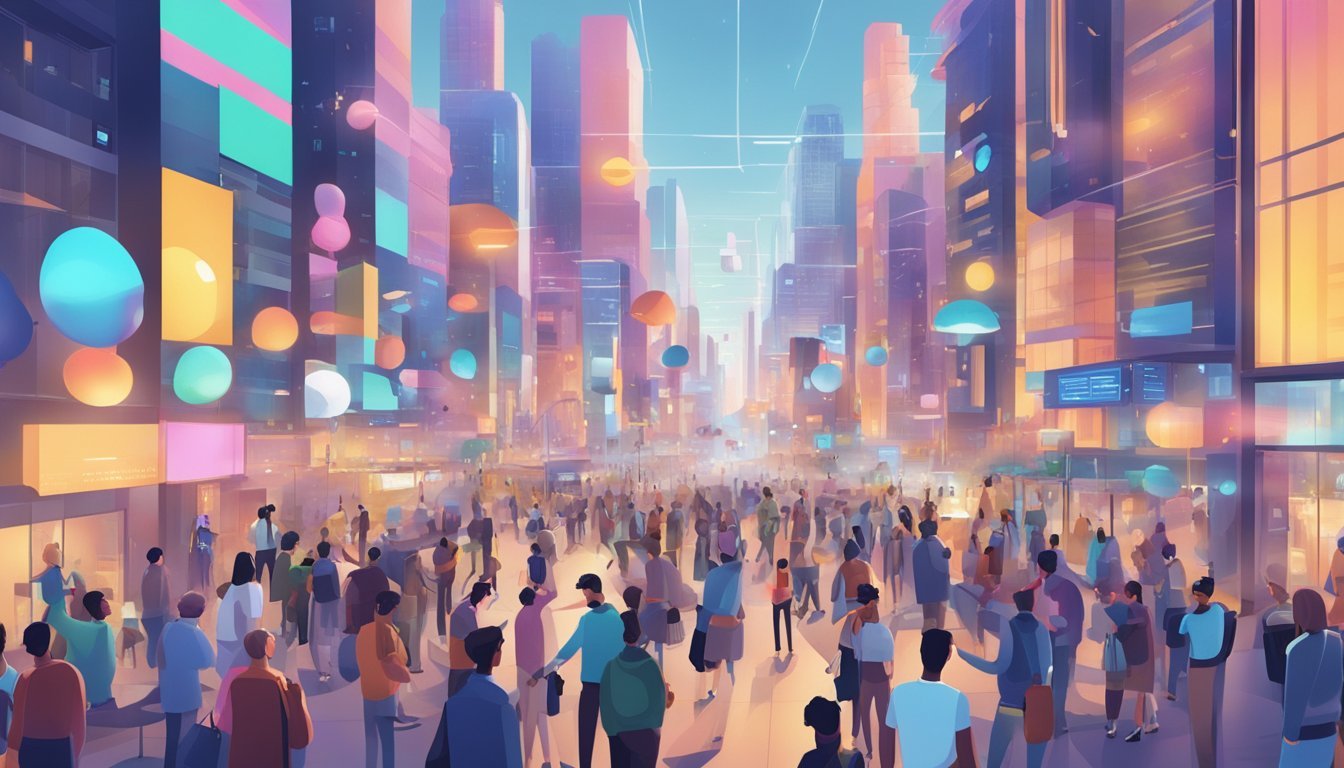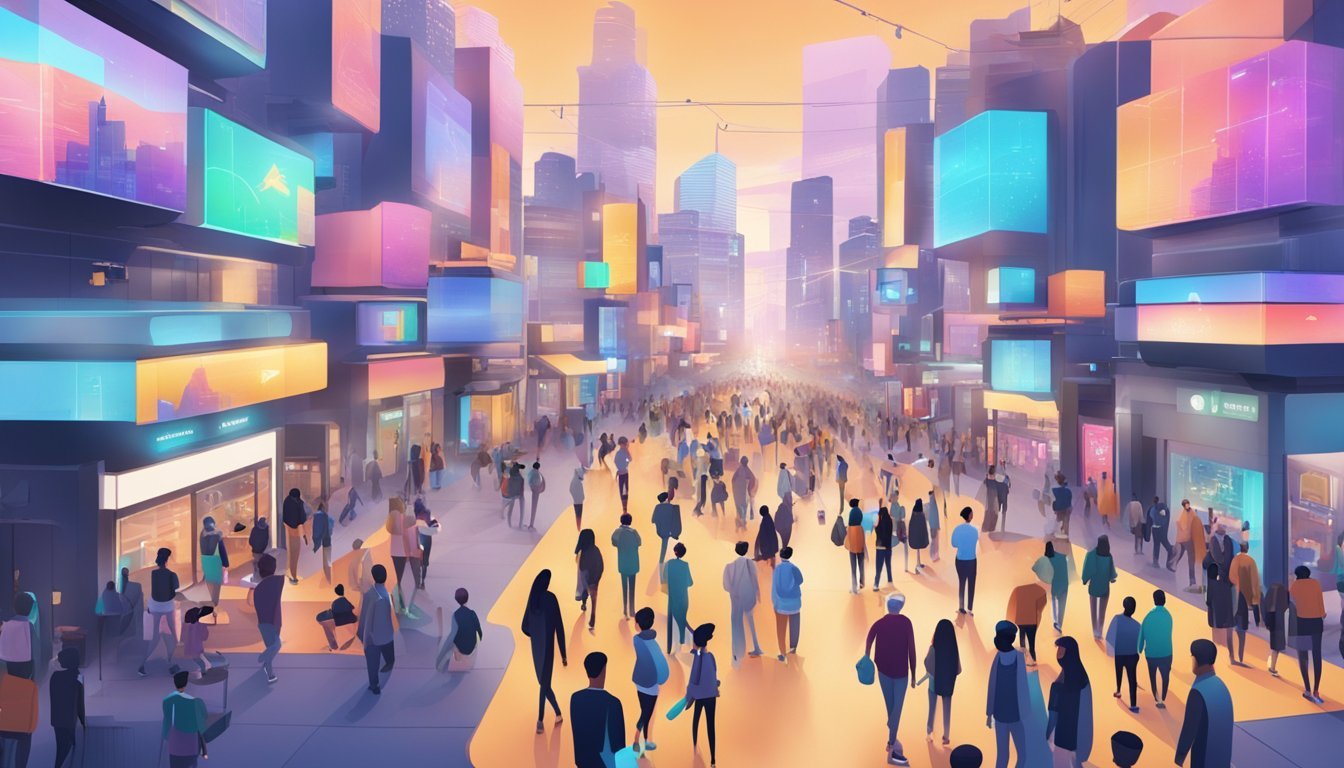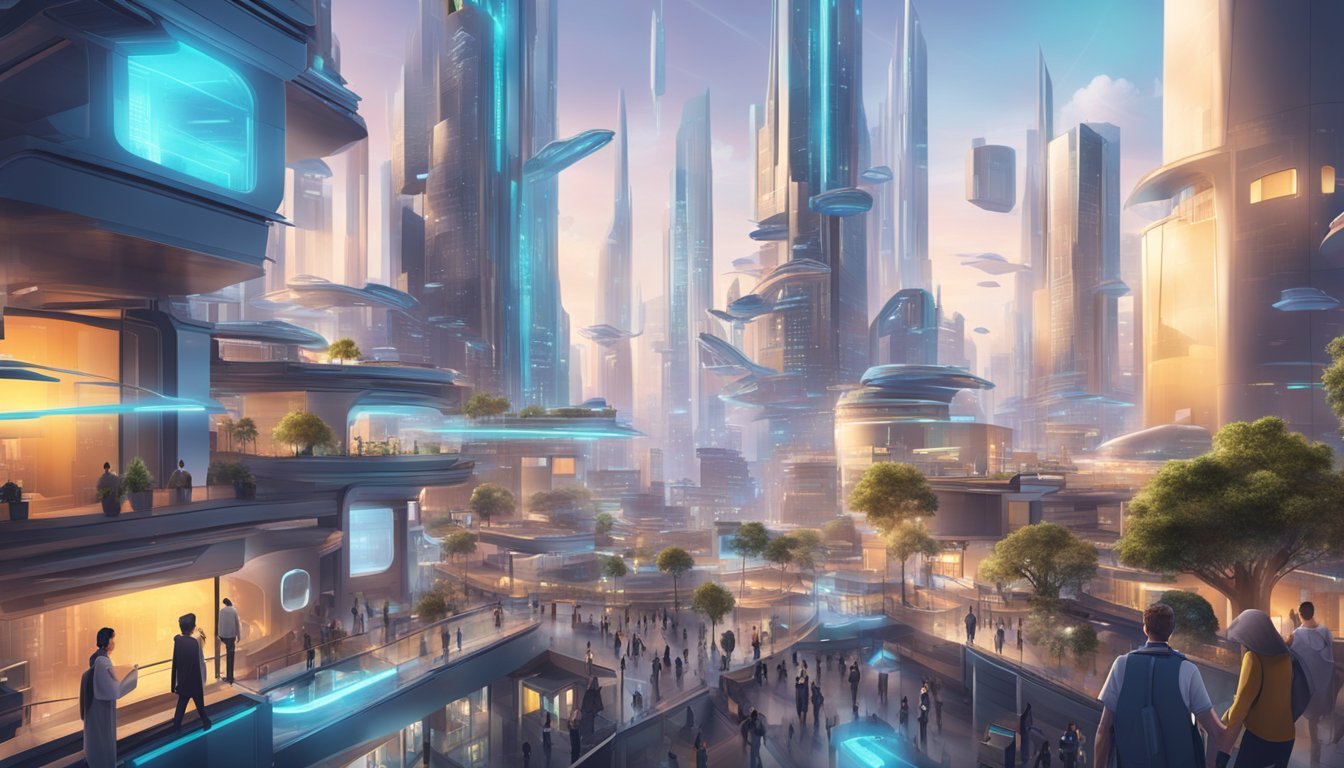Virtual Societies Unveiled: The Metaverse's Impact on Social Dynamics
The Metaverse represents an evolutionary leap in how people connect with digital content, blending virtual reality (VR), augmented reality (AR), and other technological advances to create interconnected virtual worlds. It is an expansive network that encompasses numerous digital spaces, allowing users to interact with each other and digital objects in real-time. This integration of the virtual and physical realms is reshaping social interactions and the concept of community, as it offers a new platform for people to gather, work, and play regardless of their physical location.
As society incorporates the Metaverse into daily life, it influences various aspects of human behavior and culture. These impacts are multifaceted, affecting everything from socialization and entertainment to business and education. The Metaverse facilitates new forms of communication and collaboration, giving rise to communities that exist purely in digital forms. The interaction within these virtual spaces can mirror real-world dynamics but also introduce unique experiences that are only possible in a fully digital environment.
While the potential of the Metaverse is vast, it also raises questions about the long-term implications on society. The transition towards a more immersive digital existence presents challenges such as ensuring equitable access, promoting psychological well-being, and addressing concerns around data privacy and security. As these virtual environments become more prevalent, their influence on societal norms and the very fabric of human interaction will continue to grow, necessitating ongoing discourse and careful consideration of the Metaverse's societal impact.
Evolution of the Metaverse
The metaverse has transitioned from a fictional concept to a concrete, evolving digital ecosystem. This section explores the historical origins, technological progress, influential companies, and the importance of universal standards in shaping the metaverse.
Historical Context
Neal Stephenson coined the term "metaverse" in his 1992 novel Snow Crash, envisioning a virtual space where people, represented as avatars, interact just like they do in the physical world. This concept of virtual worlds has since leaped from pages to reality, laying the groundwork for today's metaverse platforms that aim to create persistent and synchronous online environments where users can work, play, and socialize.
Technological Advancements
As technology advanced, the potential for a metaverse grew. The evolution of high-speed internet, virtual reality (VR), and augmented reality (AR) technologies have been pivotal. Microsoft, with its mixed reality platform, has contributed to the spatial computing aspects necessary for a metaverse, while Facebook, following its rebranding to Meta, has invested heavily in VR to facilitate more immersive experiences.
Key Players and Platforms
Mark Zuckerberg's Meta has become synonymous with the metaverse push, advocating for a unified, interoperable environment. Alongside Meta, companies like Microsoft play significant roles in developing the infrastructure and experiences that define the metaverse. Their platforms are poised to set the stage for how people will interact in these new digital realms.
Standards and Interoperability
For the metaverse to thrive, interoperability—the ability for diverse virtual environments to connect and interact—is essential. This calls for industry-wide standards that support creative, economic, and social activities across different platforms. A commitment to interconnectivity ensures that as the metaverse expands, it remains an integrated and accessible space for all users.
Metaverse and Society
The Metaverse is transforming societal interactions and individual behaviors, as it introduces new forms of identity through avatars, community dynamics, and challenging issues such as privacy and racism.
Social Interactions
In the Metaverse, users engage in virtual spaces that simulate real-world interactions. These spaces enable individuals from diverse backgrounds to connect, collaborate, and socialize in ways that transcend physical boundaries. For example, in the Metaverse, one can attend concerts, participate in virtual meetings, and join gaming adventures with others.
Digital Identity and Avatars
Avatars function as digital twins in the Metaverse, giving users a unique identity that can be customized to their liking. These digital representations allow for a complex expression of self and foster a sense of belonging within digital communities. The choice of an avatar's appearance can significantly influence social experiences and how others perceive an individual in the virtual realm.
Community and Behavior
The evolving norms within Metaverse communities significantly affect behavior and attitudes. While these communities can be sources of innovation and creativity, they also pose challenges such as enforcing codes of conduct to ensure safety and respectful interaction. The anonymity avatars provide can sometimes lead to negative behaviors, including bullying.
Societal Challenges
With the rise of the Metaverse, societal challenges concerning privacy, data protection, and the psychology of digital interaction become more apparent. Users must navigate issues related to digital identity, including the potential for misuse of personal information. Moreover, ensuring the safety and well-being of users, and preventing discriminatory behavior are critical concerns that are yet to be fully addressed in these expansive digital spaces.
Economic Implications
The expansion of the Metaverse brings a profound reimagining of traditional economic structures, with a significant shift towards virtual economies, transformation in business operations, and the rise of digital assets and NFTs. These elements collectively contribute to an evolving digital economy.
Virtual Economy
In the Metaverse, the virtual economy is taking shape, simulating a real-world system of supply and demand. Users engage in shopping within this economy, purchasing digital content and services. Virtual goods and exclusive experiences are monetized through in-world currencies or cryptocurrencies, making the Metaverse a new frontier for economic activity. Businesses are finding opportunities in creating virtual products or services that cater to the needs and desires of digital citizens.
Business and Employment
The Metaverse is altering the landscape of business and employment, hosting business meetings and collaborative spaces that transcend geographical limitations. Companies are establishing offices in virtual environments, cutting down on physical infrastructure costs while boosting global accessibility. Job roles are evolving too, with opportunities for digital architects, virtual event planners, and more. The Blockchain technology underpinning many of these platforms ensures secure and transparent transactions, enhancing trust in virtual interactions.
Digital Assets and NFTs
Digital assets, particularly NFTs (Non-Fungible Tokens), have become synonymous with ownership in the Metaverse. They represent a wide range of items from artwork to real estate, creating an ecosystem of asset trading backed by blockchain technology. This has not only opened a market for verifiable digital assets but also introduced new forms of investment and asset appreciation. However, it is essential to recognize both the potential and the volatility inherent in these digital commodities.
Metaverse Technologies
Metaverse technologies form the cornerstone of an integrated digital experience, leveraging advancements across various domains to create a seamless virtual space.
Hardware and Infrastructure
In the metaverse, robust hardware and infrastructure are foundational. They require powerful computing capacity and high-speed internet connectivity to handle the influx of data and users. Pioneering companies in this space are developing specialized hardware such as VR headsets and sensors to enable immersive experiences. Infrastructure also encompasses the global networks of servers needed to ensure low-latency and high-reliability interactions within the metaverse.
Virtual and Mixed Reality
Virtual Reality (VR) and Augmented Reality (AR) are at the heart of the Metaverse's user interface, providing immersive and interactive ways to experience digital content. VR immerses users in a fully artificial environment, while AR overlays digital information onto the physical world. These technologies rely on advanced algorithms to render complex environments in real-time, with devices ranging from head-mounted displays to haptic feedback systems enhancing the user experience.
Artificial Intelligence and Machine Learning
Artificial Intelligence (AI) and Machine Learning (ML) technologies underpin many aspects of the metaverse, from content creation to user interactions. AI can power non-player characters and drive personalized experiences, adapting to user behavior through learning algorithms. Meanwhile, ML can analyze vast amounts of data to improve system performance and offer predictive insights, continually refining the user's experience of the metaverse.
Data Security and Privacy
Data security and privacy are paramount in the metaverse, where personal and sensitive information is often shared and stored. Effective security measures must be in place to protect against breaches, employing encryption, secure algorithms, and privacy policies designed to safeguard user data. As the metaverse intersects with technologies such as the Internet of Things (IoT), the complexity of data security increases, making constant vigilance and innovation in this area critical.
Real-world Applications
The metaverse has transcended beyond being just a concept and is now seeing practical use in sectors such as education, healthcare, entertainment, and tourism. These applications are redefining how people learn, heal, play, and explore.
Education and Training
Education in the metaverse provides an immersive learning environment where students can interact with educational content in a three-dimensional space. For example, platforms like Minecraft Education Edition are already being employed in schools to enhance creativity, problem-solving, and teamwork. Training scenarios, from corporate workshops to military simulations, benefit from realistic and engaging environments, offering the opportunity for hands-on experience without physical constraints.
Health Care and Telemedicine
In health care, the metaverse allows patients and doctors to connect through telemedicine, providing access to consultations and care that may have been geographically challenging before. Surgeons and medical professionals use these virtual spaces for collaborative training and to simulate surgeries, thereby reducing the risks associated with inexperience and increasing the quality of healthcare delivery.
Entertainment and Gaming
Entertainment and gaming have been revolutionized by the metaverse, providing users not just games, but experiences. Popular titles like Fortnite and Grand Theft Auto have created vibrant communities and virtual economies. They offer not only leisure activities but also virtual concerts and sports events, creating a blend of real-world and virtual experiences.
Travel and Exploration
The metaverse makes travel and exploration accessible from the comfort of one's home. With virtual tours, historical sites and museums can be visited, fostering a new form of cultural engagement. Applications such as Google Earth VR allow users to experience different locales as if they were truly there, pushing the boundaries of real-world exploration without the physical and economic limitations of travel.
Cultural and Psychological Impact
The Metaverse is reshaping society's cultural landscapes and psychological patterns, emphasizing the importance of understanding its social consequences. Individuals' behaviors and expressions are being influenced by the evolving digital spaces that create profound immersive experiences.
Behavioral Changes
In the Metaverse, behavioral changes are noticeable as individuals adapt to new modes of interaction. These changes are driven by the technology that enables a presence akin to real life. People's abilities to have a digital twin represent them in various settings leads to a shift in how they socialize, learn, and work. The constant feedback loop between user behavior and AI-driven environments facilitates a dynamic where artificial intelligence influences behavior, which in turn shapes AI development.
Increased Online Socialization: Users are spending more time socializing in digital environments, which can affect offline behavior.
Privacy Concerns: With substantial data being collected, concerns about privacy and behavior tracking are influencing user conduct.
Impact on Art and Expression
The Metaverse paves the way for unparalleled art and expression, leveraging the interactivity of digital content. Artists can now create and share art in ways that were previously unimaginable.
New Artistic Mediums: Engaging with art through VR removes physical bounds, ushering in innovative forms of expression.
Collective Art Experiences: Shared spaces allow for collaborative art, revolutionizing the concept of community-driven projects.
Perception of Reality
The Metaverse's potent immersive experience alters the perception of reality, as the line between physical and digital realms becomes blurred. Psychological research is beginning to explore the implications of prolonged engagement in virtual spaces on people's perception of their actual environment.
Virtual Presence Impact: The sensation of being physically present in a digital world can alter one's sense of presence in the real world.
Real-world Skill Transfer: Skills acquired in the Metaverse might translate to the real world, suggesting a mutual influence between both realities.
Challenges of the Metaverse
The Metaverse poses significant hurdles ranging from ethical dilemmas to technical constraints. As stakeholders navigate these waters, they must tackle issues of privacy, adhere to evolving regulatory frameworks, and mitigate any potential negative social impacts.
Ethical Considerations
One must consider the ethical implications of creating virtual spaces that can influence real-world behavior. For instance, privacy concerns become paramount as companies like Apple introduce VR goggles and other devices that track user’s movements and interactions. There is a delicate balance between personalization and invasive data collection that developers and consumers alike must address.
Technical Limitations
Despite advancements in technology, connectivity and hardware limitations persist. Users with inadequate internet speeds or outdated equipment may face barriers to entry, which can lead to a digital divide. Furthermore, ensuring safety within the metaverse is challenging as virtual reality can potentially cause motion sickness or disorientation.
Regulatory Frameworks
Developing a comprehensive regulatory framework for the metaverse is complex given its global reach and the blending of digital and physical realms. Governments and policymakers are struggling to keep up with the pace of technological innovation, making it difficult to establish standards that protect users without stifling growth.
Negative Social Effects
It's also crucial to recognize the potential negative social effects of the metaverse. Issues like cyberbullying, harassment, and the spreading of misinformation can be magnified in such an immersive environment. As users spend increasing amounts of time in virtual settings, the impact on societal behavior and interpersonal relationships must be closely monitored.





